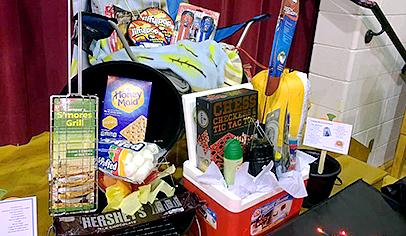Without volunteers, parent groups wouldn’t be able to accomplish nearly as much. But parents are busy, overwhelmed with obligations to their families, jobs, and communities. So how do you get people to sign up to help, and then how do you keep them involved?
Successful recruiting for volunteers often begins well before the school year. Some parent groups make a pitch for involvement during spring of the previous year, especially for the parents of a primary school’s incoming kindergartners.
At Robert Gisler Elementary in Fountain Valley, Calif., the PTO gives a presentation to this group at the spring kindergarten roundup, explaining what the PTO does and what kind of assistance is needed. Then these parents and their children are given free tickets to the school’s May carnival. “We invite them so they can see what we do,” says PTO president Jennifer Salamon. “The new parents look so deer-eyed; they think it’s scary. But they come and see all the fun we have.”
Another key time for recruiting is at registration before school begins in the fall. The Parents in Partnership group at Shakopee Area Catholic School in Minnesota distributes a pamphlet at registration describing its L.O.V.E. (Lots of Volunteer Energy) program. Each family is asked to contribute 30 volunteer hours per year and to identify their top five volunteering choices from a list that includes coaching, selling raffle tickets, cutting out labels and UPC codes at home, and helping with Junior Achievement, among other opportunities.
While some private schools ask for a significant commitment, as Shakopee Area Catholic School does, many other schools find success by asking parents to commit to two or three hours a semester. Asking for a specific, small commitment can result in hundreds of volunteer hours. And if people have a positive experience when they volunteer, often they will far exceed the original two-hour request. (PTO Today’s 2 Hour Power program provides free materials for this kind of pledge program.)
The Tilton Elementary PTO in Rochelle, Ill., hosts a balloon-decorated booth at back-to-school night, inviting parents to sign up to volunteer and promoting special incentives. For every three hours individuals volunteer, they get to put their names into a year-end drawing for some kind of family activity. One year, the prize was a bowling package at a local bowling alley; another time it was a family season pass to the water park in the next town.
Keep Reaching Out
During the school year, outreach through emails, newsletters, and bulletin boards can bring in additional volunteers. Some schools also use social networking. “We just started using Twitter in the fall,” says Jodie Hart, PTO president at Tilton. “We haven’t gotten a whole lot of responses yet; it’s still quite new to a lot of families.” And many groups have found Facebook to be a powerful way to connect with parents.
Even more effective is a personal invitation. “I spend a lot of time at school,” Hart says. “If I see parents I’ve never met, I walk up and introduce myself and ask if they’re available to volunteer. There are so many people out there who want to help. I rarely get turned down.”
And keep an eye out for particular talents. “If you know somebody who decorates the heck out of their house for Halloween or throws big Christmas parties, those are people to pull in for the fall carnival or the holiday shop,” says Barbra Chase Burke, president of the Parent Teacher Involvement Committee at Roxborough Primary & Intermediate School in Littleton, Colo.
It’s also worth reaching out to families who enroll throughout the year. “This year we formed a welcoming committee,” says Krista Riley, PTO president at Davidson Elementary in North Carolina. “Even though it’s just a handful that come in over a year’s time, they were really lost and felt like they couldn’t catch up. We’ve found some great volunteers that way.”
The Davidson PTO has also decided to try to make all parents feel more welcome by getting rid of its membership fee. “We had a board meeting and decided not to charge dues next year,” Riley says. “We agree that everyone belongs to the PTO.” The group doesn’t want a membership fee to make anyone to feel excluded, she says.
Make Contact Early
Once people volunteer, it’s important to contact them quickly. This lets them know that you received their information, that their willingness to volunteer is valued, and that you truly need their help. “The worst thing is for someone to volunteer and then not hear from you,” Salamon says.
The Davidson PTO collects volunteer interest forms at the start of the year, and within three weeks each committee chairperson receives a list of volunteers to contact by email. The chairpeople introduce themselves and explain the event and what the volunteers will be doing. This approach helps fine-tune the volunteer lists since some parents may realize one event isn’t as good a fit as they thought, and they’ll still have time to sign up for something else.
In addition, says Riley, “This year we tried to personalize the emails. One chair starts with a mass mailing but then contacts everyone, volunteer by volunteer. The result is that people feel more like they’re making a difference.”
Then, when the volunteers show up to help, be sure that you’ve got something for them to do. “We’re very sensitive about that,” Riley says. “In this economy, people’s time is important. We communicate the parameters of the volunteer opportunity well in advance. You’re not just signing up for Earth Day; you’ve got the morning shift and this is what you’re expected to do and this is where you’ll report.”
Lisa Frank, a board member of Shakopee’s PIP group, recommends a central check-in station for volunteers. “Have people come in and check off that they’ve shown up,” she says. “A coordinator is good to have so people don’t feel like they’re just standing around.” Volunteer schedules posted at each station help parents know when their shifts begin and end, and these lists also facilitate parents getting to know each other.
Experienced parent leaders also recommend not overrelying on new volunteers, who are more likely to stick around if their involvement increases gradually. “If you throw too much at them, they get scared and can’t handle it,” Salamon says. “It won’t be any use to you or the school if you burn them out too quickly.”
Over the course of two or more years, a volunteer might move from spending two hours running a game at a carnival to overseeing ticket sales to coordinating the event, for example. “If you have a strong frog game volunteer who shows up on time and is cheery and fun, that’s a good person to approach to say, ‘Would you help us lead the entire event next year? Can I take you out for coffee and I’ll fill you in?’” Burke says.
The More Information, the Better
It also helps to clearly define the duties of a position. When the Gisler PTO was in need of a treasurer, the principal identified a parent who was an accountant, and the group explained the duties and the minimum effort required. “It helps people to understand that it’s not brain surgery,” Salamon says. “We said, ‘You can do more, but this is all we need you to do.’”
Burke suggests describing the skill set for the position you’re seeking to fill and to note whether there would be a conflict for a working parent. “If you’re clear, you’ll be shocked at how many people will say ‘I can do that,’” she says. And emphasize the benefits: “Talk about the fun and the networking you’re experiencing.”
It also helps to have shared responsibilities or job shadowing for leadership positions. The Roxborough PTIC uses up to four chairs for each event. “The cool thing about co-, tri-, or quad-chairs is that you can pair two experienced people with two newbies,” says Burke. “That is the key to preventing burnout and attrition. Out of 100 people in leadership positions, we have an attrition rate of less than 20 percent year over year.”
Be careful not to discourage involvement by quashing new ideas. Hart remembers a parent who wanted to run the annual carnival and proposed some drastic changes, including moving everything outdoors, renting portable toilets, and purchasing expensive invitations in lieu of flyers. “There was a lot of negative talk about spending so much money,” says Hart, who supported the chairwoman’s decisions. Even though the event only broke even, “families had an amazing fun time,” Hart says. “And she came up to me and said thanks for letting her run with it. Then she volunteered the next year for a different event.”
Also, be flexible enough to find a niche for everyone. “I approach a parent and say, ‘Tell me what you’re interested in and I bet we have a place for you,’” says Davidson PTO’s Riley. “They may say ‘I used to do PR’ or ‘I’m a project person; I don’t want to be responsible but want a small project to work on’ or ‘I can only work on my computer at home.’ One of those parents could work on a small event we do for all the boys; another could write articles for the newspaper. There’s always some way that someone can get involved.”
Finally, don’t forget to say thanks. Hart expresses appreciation while the parents are volunteering. “I make a point to go to each one and say thanks and are you having fun and will you return and what could we do better,” she says.
When the Davidson PTO sends out a mass thank-you email to volunteers after an event, the principal is copied, and PTO president Riley replies to everyone to emphasize how thankful she and the teachers are for the parents’ help.
At Shakopee’s volunteer appreciation social at the end of the year, teachers send out the invitations, parents are called up at Mass for a blessing, and children present gifts they’ve made, such as fired clay bowls filled with chocolate kisses. And at Gisler, personalized thank-you gifts are presented to board members. The outgoing PTO president, for example, received a plastic platter on which other parents had written notes with indelible marker noting appreciation for her efforts, such as “Thanks so much for the radios.”
Perhaps the most important part of a parent group’s message about volunteering is that it’s fun. “I come from the fact that we’ve made some of our best friends from doing this,” Salamon says. “I present it this way: We spend so much time working for a common goal, and we have kids the same age, but we might not have met otherwise.”

























